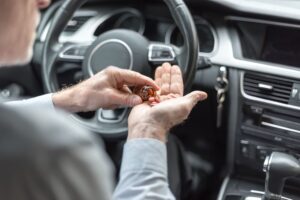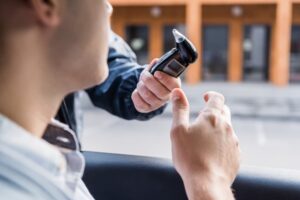The answer is: disturbingly common, and it’s a scourge on our roads. Millions of people admit to getting behind the wheel after using illicit drugs, and a substantial percentage of fatal crashes involve drivers with drugs in their system.
If you or a loved one has been hit by a driver you suspect was impaired, you don’t have to figure this out alone. Call Cook, Barkett, Ponder & Wolz’s drunk driving accident lawyer serving in Cape Girardeau at (573) 335-6651 for a straightforward conversation about your situation.
The Scope of the Problem: Just How Common is Drug-Impaired Driving?
In the last five years, there has been a disturbing increase in crashes involving drugs. Consider this: in 2021, a shocking 18% of traffic fatalities involved drivers who tested positive for two or more impairing drugs. This often involves more than one substance; it’s frequently a cocktail of impairment, making drivers even more dangerous. Poly-drug use, the presence of multiple substances, significantly complicates the picture of impairment.
States are trying to adapt their approaches to this growing threat. For instance, to improve roadside detection, as of December 2023, 27 states authorized oral fluid testing for drug impairment. This method allows officers to take a saliva sample, which can be screened for various drugs, potentially providing quicker indicators of impairment than waiting for blood tests. Improved detection is a step toward accountability.
However, collecting comprehensive data on drug-impaired driving is more challenging than for alcohol. There’s a vast array of drugs, both legal and illicit, that can cause impairment. Standardized testing for all of them isn’t as straightforward as a breathalyzer for alcohol. This means the statistics we do have, as alarming as they are, might not even capture the full extent of how common drug impaired driving truly is.
How Many People Exactly Are Driving Under the Influence?
In 2021, a staggering 11.7 million people aged 16 and older reported driving under the influence of illicit drugs in the past year. To put that in perspective, that’s more than the entire population of many states, all getting behind the wheel impaired.
The types of drugs involved are varied and all pose significant risks:
- Marijuana: Often perceived as less harmful by some, its impact on driving abilities is well-documented.
- Opioids: Including prescription painkillers and illicit drugs like heroin, these substances severely dull reflexes and cognitive function.
- Stimulants: Drugs like cocaine and methamphetamine can lead to aggressive and erratic driving.
- Prescription Medications: Even when taken as prescribed, some medications like sedatives, muscle relaxants, or certain antidepressants can impair driving ability. Always check warnings.
The impact on road safety is undeniable. Some controlled studies have found that drivers testing positive for THC (the psychoactive compound in marijuana) were about twice as likely to be involved in a fatal crash compared to drivers who had not used drugs or alcohol.
Opioids are a major piece of this grim puzzle. For example, back in 2016, of drivers involved in fatal crashes who were tested and found to be under the influence of drugs, 19.7% tested positive for opioids. This includes both prescription and illicit opioids—the fact that a drug is prescribed doesn’t make it safe for driving.
When we talk about demographics, younger drivers, particularly males, are often overrepresented in drugged driving statistics, but this problem spans all age groups and genders.
What Does the Law Say About Drugged Driving?
General Impaired Driving Laws (DUI/DWI)
Most people are familiar with terms like DUI (Driving Under the Influence) or DWI (Driving While Intoxicated). These laws generally make it illegal to operate a vehicle if your ability to do so is impaired by alcohol, drugs, or a combination of both. The key is impairment, regardless of the specific substance.
The National Highway Traffic Safety Administration (NHTSA) publishes a Digest of Impaired Driving and Selected Beverage Control Laws, which is a comprehensive compilation of state laws regarding DWI offenses, chemical testing protocols, and license sanctions.
In Missouri, for example, like all states, it’s illegal to drive while in an intoxicated condition, which includes impairment by drugs, alcohol, or a combination. The specifics of how “intoxication” is legally defined and proven are complex, particularly with drugs. (For specific Missouri statutes, one would refer to the Missouri Revisor of Statutes, such as Chapter 577).
Specific “Per Se” Drug Driving Laws
“Per Se” laws take a more direct approach. In the context of drugs, a per se violation means it’s unlawful to drive if the amount of a specific drug (or its metabolites) in your blood or urine exceeds a legally defined limit. With these laws, the prosecution doesn’t necessarily have to prove you were observably impaired; the presence of the drug above the threshold is enough for a conviction.
Some states have zero-tolerance per se laws for certain illicit drugs, meaning any detectable amount is illegal. Other states have established specific concentration limits for substances like THC. However, setting these limits is scientifically more complex for drugs than for alcohol, as the correlation between a drug’s concentration in the body and the degree of impairment isn’t always as clear-cut as it is with BAC (Blood Alcohol Content).
Implied Consent Laws
When you get a driver’s license, you’re also agreeing to something called “Implied Consent.” This legal principle means that by operating a vehicle on public roads, you have automatically consented to submit to chemical tests (like blood, breath, or urine tests) if you are lawfully arrested for suspected impaired driving.
Refusing such a test when suspected of drug-impaired driving isn’t a get-out-of-jail-free card. In fact, refusal often carries severe administrative penalties, such as an automatic and lengthy driver’s license suspension, regardless of whether you are ultimately convicted of the DUI itself. This shows how seriously the legal system views the need to test for impairment.
Drug Recognition Experts (DREs)
What happens when a driver seems impaired, but their alcohol breath test is low or zero? This is where Drug Recognition Experts (DREs) come in. These are law enforcement officers who have received specialized training to identify impairment due to drugs other than, or in addition to, alcohol.
The DRE program involves a standardized 12-step evaluation process that looks at a variety of physiological and behavioral indicators. This systematic approach helps officers form an opinion about the category of drug(s) causing impairment. A DRE’s testimony and evaluation is powerful evidence in a drug-impaired driving case, especially when chemical test results are pending or complex.
Penalties for Drug-Impaired Driving
- Hefty fines
- Jail time (from days to years, especially for repeat offenses or if causing injury/death)
- Mandatory driver’s license suspension or revocation
- Installation of an ignition interlock device (less common for pure drug DUIs but possible)
- Court-ordered substance abuse education or treatment programs
Beyond the criminal courts, there’s civil liability. A drugged driver is, and should be, held financially responsible for the harm they cause to others. This includes medical bills, lost wages, property damage, and compensation for pain and suffering. This is where a personal injury claim comes into play, and where firms like Cook, Barkett, Ponder & Wolz step in to advocate for victims.
The Aftermath: What Victims of Drug-Impaired Driving Need to Know
The Unique Challenges of Drugged Driving Cases
Proving impairment from drugs is more complex. Some drugs metabolize quickly, meaning delays in testing impact results. The sheer variety of substances means there isn’t a single, simple test like a breathalyzer that covers everything.
Furthermore, linking a specific drug level in a driver’s system directly to the degree of their impairment is more nuanced than with alcohol. This is why prompt investigation and thorough evidence preservation are absolutely fundamental. This includes securing:
- The official police accident report (and any supplemental reports)
- Witness statements and contact information
- All medical records related to your injuries
- Photos and videos of the accident scene, vehicle damage, and your injuries
- Any available vehicle data recorder (“black box”) information
Your Rights as a Victim
As a victim of a drug-impaired driver’s negligence, you have the right to seek compensation for the harm you’ve suffered. Compensation, often referred to as “damages,” covers a range of losses:
- Medical Expenses: Current and future costs for hospital stays, surgeries, doctor visits, medication, rehabilitation, and therapy.
- Lost Wages: Income lost because you were unable to work, and diminished future earning capacity if your injuries are long-term or permanent.
- Pain and Suffering: Compensation for physical pain, emotional distress, mental anguish, and loss of enjoyment of life.
- Property Damage: Costs to repair or replace your vehicle and any other personal property damaged in the crash.
- Other losses: Depending on the circumstances, other damages might be applicable.
Statute of Limitations
There’s a deadline for filing a lawsuit, known as the statute of limitations. If you miss this deadline, you generally lose your right to seek compensation through the courts, no matter how strong your case is.
The statute of limitations for personal injury claims varies by state. For instance, in Missouri, the general statute of limitations for personal injury is five years from the date of the injury (Missouri Revised Statutes section 516.120), but there are exceptions and nuances. Consulting with an attorney promptly is the best way to ensure your rights are protected.
FAQ: Your Questions About Drug-Impaired Driving Answered
It’s natural to have a lot of questions when dealing with something as serious as drug-impaired driving. Here are some common ones:
- Can I sue if the driver was impaired by a legally prescribed medication?
Yes, absolutely. “Legally prescribed” does not mean “safe to drive.” If a medication, even one prescribed by a doctor, impairs a person’s ability to operate a vehicle safely, and they choose to drive and cause an accident, they are held negligent and liable for the damages. Many medications come with warnings against operating heavy machinery, which includes cars.
- What if the drug test results take a long time or are inconclusive?
While drug test results are important evidence, a case doesn’t solely hinge on them. A strong case is often built using other evidence, such as the arresting officer’s observations of impairment (erratic driving, slurred speech, poor coordination), witness testimony, the DRE evaluation (if one was performed), admissions made by the driver, and evidence from accident reconstruction.
- Does car insurance cover damages caused by a drugged driver?
Typically, the at-fault driver’s bodily injury liability insurance should cover the damages up to their policy limits. However, there are complications. If the driver was uninsured or their coverage isn’t enough to cover your losses (underinsured), your own Uninsured/Underinsured Motorist (UM/UIM) coverage might apply, if you have it.
- How is “impairment” defined legally when it comes to drugs?
Legally, impairment generally means that a drug (or drugs) has affected the driver’s ability to operate a vehicle in a reasonably safe manner. This manifests as diminished judgment, slowed reaction time, poor coordination, altered perception, or other deficits. For some drugs and in some jurisdictions with “per se” laws, having a specific concentration of the drug in one’s system is enough to define impairment legally, regardless of observable signs. In other cases, impairment is proven through a combination of evidence showing the driver’s compromised state.
- What’s the difference between a criminal case and a civil case for drugged driving?
A criminal case is brought by the state (the prosecutor) against the impaired driver. The goal is to punish the driver for breaking the law (e.g., fines, jail time, license suspension). A civil case is brought by the victim (the plaintiff) against the impaired driver (the defendant). The goal of a civil case is to obtain financial compensation (damages) for the victim’s injuries and losses. These two types of cases proceed separately, though a criminal conviction is sometimes used as evidence in a civil case.
- If the other driver passed a breathalyzer for alcohol, can they still have been impaired by drugs?
Absolutely, yes. A breathalyzer only detects alcohol. A result of 0.00% BAC simply means alcohol wasn’t the issue (or wasn’t above the detection threshold). It says nothing about the presence or influence of other drugs, including marijuana, opioids, stimulants, or prescription medications. This is a key reason why further investigation, including DRE evaluations and specific drug testing, is so important when impairment is suspected despite a clear alcohol test.
Don’t Let a Drugged Driver Steal Your Future
If your life has been turned upside down by someone else’s reckless decision to drive impaired, you deserve clear answers and strong advocacy. The team of Cape Girardeau injury lawyers at Cook, Barkett, Ponder & Wolz is here to listen and help you understand your legal options.
Call us today at (573) 335-6651 – let us help you on the road to recovery and justice.






